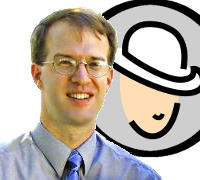When you purchase through links on our site, we may earn an affiliate commission (details)
How to Harness the Habits of Your Customers
by Antone Roundy | Add Your Comments | Marketing, Product Reviews
Your customers have 3 brains. No, I'm not saying they're mutants or aliens -- I mean 3 parts of their brains are involved in making decisions. If you want them to choose you, you need to know which one to talk to and how to do it.
The "Lizard Brain"
The first is the part of the subconscious that some people call the "lizard brain". It's the primitive part of the brain that makes quick, reflexive decisions based on survival instincts.
The Behavioral/Habitual Brain
The second part is also subconscious, but is more complex. It deals with learned behavior, including complex scripts for how to respond to various stimuli and situations -- also known as "habits".
The Reflective/Executive Brain
The third is the conscious mind. Interestingly, the conscious mind doesn't have direct access to sensory input, and surprisingly, some people believe it doesn't directly control behavior (if it does, it certainly doesn't have as much control as it thinks).
The conscious mind monitors information that's passed on to it about sensory input, and influences decisions. But if you want to influence peoples' decisions, it's not the most important part of the brain to speak to. You'll want to satisfy any objections it may have to the decisions being made by other parts of the brain, but your main message needs to be directed elsewhere.
Speaking to the Subconscious
It's not hard to find marketers talking about the need to address the "lizard brain". Dig deep and discover your customers' needs and fears -- the things that keep them awake at night -- and address those. It's important to realize that the lizard brain doesn't directly process language, so your messages to it need to evoke imagery and other sensory stimuli that it can understand.
What's discussed less often is speaking to the behavioral part of the brain -- how to tap into the scripts and habits that people run on auto-pilot, and direct them toward purchasing your products.
- What do your customers already do habitually? Can you inject your product into those behavior patterns?
- What do they habitually avoid doing, even though they know they shouldn't? Can you offer them a product or service that does it for them? How can you convince them to turn the job over to your product?
- Which of their habitual patterns can you interrupt and suggest an alternative for (ie. using your product)?
- Can you influence them to replace a bad habit with a good habit that involves using your product? (Hint: try tying the new habit to the same stimuli or situations and used to trigger the old one.)
"Habit: The 95% of Behavior Marketers Ignore"
Everything I've written here is from the notes I took while reading "Habit: The 95% of Behavior Marketers Ignore" by Neale Martin [affiliate link].
Here's more from my notes:
"It's the Same, Only Different..."
It's difficult to create new habits and patterns of thinking in your customers. So it's easier to introduce a product if you balance the need to make it unique enough to be interesting with making it similar enough to things they're already familiar with that they know how to categorize and think about it.
A good way to do this is to introduce it in terms of what it's not. For example, Web Entrance Messenger isn't a monolithic web analytics package like Google Analytics -- it's a tool that let's you instantly see where your traffic is coming from right now, and enables you to add content to your pages that is only shown only to people coming from specific traffic sources. It does some analytics, but its focus is on quick information (you don't have to wait till tomorrow to see where today's traffic is coming from) and customizing content.
Stories and analogies help people relate new ideas to their existing internal representations of how their world works. By using stories and analogies to talk about your product, you help people see how your product fits into their world, and you do it in a way that their behavioral mind can understand.
Reinforcing Desirable Behavior
If you can get people to do something you'd like them to repeat (visit and/or comment on your blog, use your product, etc.), it's helpful to reinforce the desirable behavior by rewarding it. But interestingly, it turns out, reinforcement is more effective if it doesn't occur every time. If it occurs every time, it becomes routine and expected (ie. it feels like an entitlement, not a gift). If not, it's anticipated and hoped for.
Internet marketers need to understand is that reinforcement can only happen after the behavior has occurred. The "bribes" that people offer to get people to join their mailing lists speak to the conscious mind because they come before the desired behavior, so offering freebies doesn't reinforce behavior.
To get a deeper understanding of these concepts and how to apply them in your business, pick up a copy of Habit: The 95% of Behavior Marketers Ignore.
One final side note: I didn't introduce this blog post as a book review, because the review I posted for Made to Stick: Why Some Ideas Survive and Others Die got significantly lower click-through from the email that announced it than most of my recent posts. There's a lesson to be learned from that.
I'm guessing "book review" turned people off because it didn't communicate the fact that the post contained information that could be applied without reading the book. I do strongly recommend reading the book -- it's one of the best I've read in a long time -- but the blog post itself was designed to be useful on it's own.
You may get less traffic from your regular subscribers by billing a blog post as a book review. On the other hand, it's possible you may eventually get more search engine traffic for a page that says "Book Review" in the title, and the traffic you get that way may be more likely to buy, because they're actively looking for information to help them to decide whether or not to buy.





